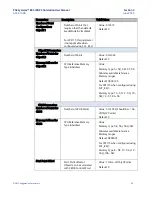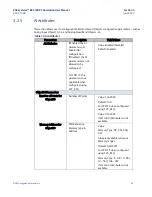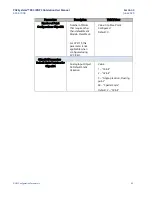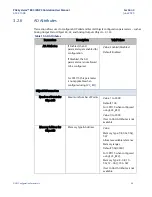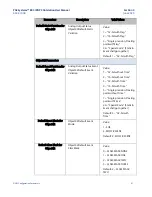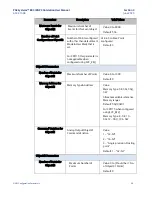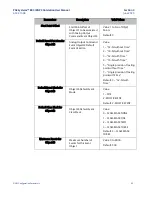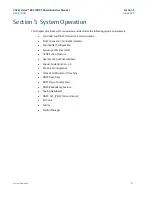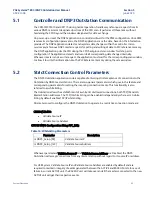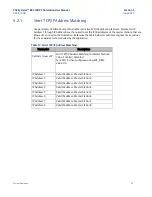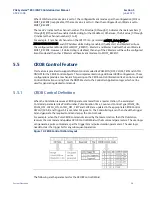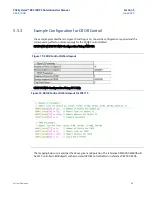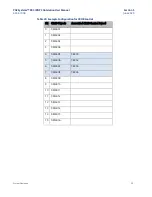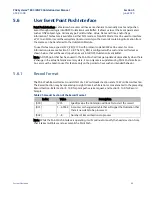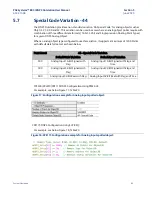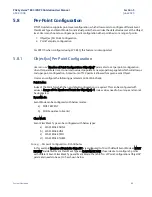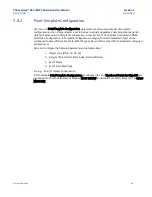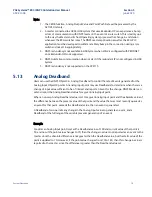
PACSystems™ RX3i DNP3 Outstation User Manual
Section 5
GFK-3103B
June 2020
System Operation
55
CPE115:
When using PME to configure a DNP3 Outstation CPU, if the maximum sum of all the configured events
exceeds 24,000, a fatal fault is logged in the PLC fault table: Exceeds 24K Events.
” The
CPU will also be
put into Stop-Fault Mode. Users will need to clear the fault condition and ensure the total number of
configured events does not exceed 24,000 events before re-downloading the configuration to the CPU.
Similarly, when using the service request sub-function, if the DNP3 configuration has more than 24,000
events an i
nformational fault is logged in the PLC Fault table: “Exceeds 24K Events”.
The DNP3
SVC_REQ command that provides DNP3 configuration status will indicate an INVALID configuration.
Users will need to clear the configuration command, change the maximum events configuration
parameters, and ensure the total number of configured events does not exceed the required value,
before performing a Run Mode Store of the block to download the required configuration. Then, users
may issue the SVC_REQ command to start the DNP3 protocol.
5.4
Sequence of Events (SOE)
Sequence of Events (SOE) is a technique whereby the DNP3 module will store events even if a master is
not connected. SOE collection will continue until such time as either the maximum storage space for
SOE storage has been exhausted, or the master connects. SOE collection can be enabled by configuring
the Event Mode as SOE in PME. For detailed description of supported Event Modes, refer Section 3.2.1.
The SOE functionality for historical/buffered events will be available for all 8 masters on the configured
DNP3 port.
SOE mode can store more than one event for a point, so a sequence of events history may be stored in
the DNP3 Outstation whenever Event Mode is set as SOE. Events can either be instances of a single
point change, or multiple changes of the same point.
The length of the Event Buffer for each individual event object is configurable and maximum buffer size
can go up to 8000 events. If buffer size is set to 0 then SOE will be disabled and the event object will
store only most recent events.
Once the Event buffer fills up, no more events data will be captured in the buffer and this will be
indicated using IIN Over Flow bit. In reporting out the buffer contents, the Outstation transmits them in
reverse chronological order: the first-recorded event will be the last event transmitted. However,
“Delete Oldest Event for Session[x]” parameter
s can be used to make the buffer circular. The Circular
buffer, in contrast, will start discarding the oldest event when the buffer for an object becomes full.
When reporting out, the first-reported event will be the oldest event captured, with the others
following in reverse chronological order.
If the objects’s channels are configured with Event Mode as SOE, then users can disable the SOE Event
Mode for the selected channel through a channel mask, using a Run mode Service Request.
When SOE channel mask value is set to 1 the configured Event mode as per the configuration (SOE or
MOST_RECENT) is applicable, If the mask value is set to 0, then the configured Event Mode is set to
MOST_RECENT.
For example, when configuring CPE400 in PME, if the number of channels configured is equal to 4, and
if mask value is set to 16#0003, the Master 1 and Master 2 will use the configured Event Mode (SOE or
MOST_RECENT), and Master 3 and Master 4 will set the Event Mode to MOST_RECENT. For more
information on Service Request sub-functions, refer to section 5.14.10.
For CPE115, when configured using SVC REQ, setting SOE to Event Mode is done by modifying
parameter mDNP3_Setup [29].x. Users can disable the SOE Event Mode for the selected channel
through a channel Mask.


